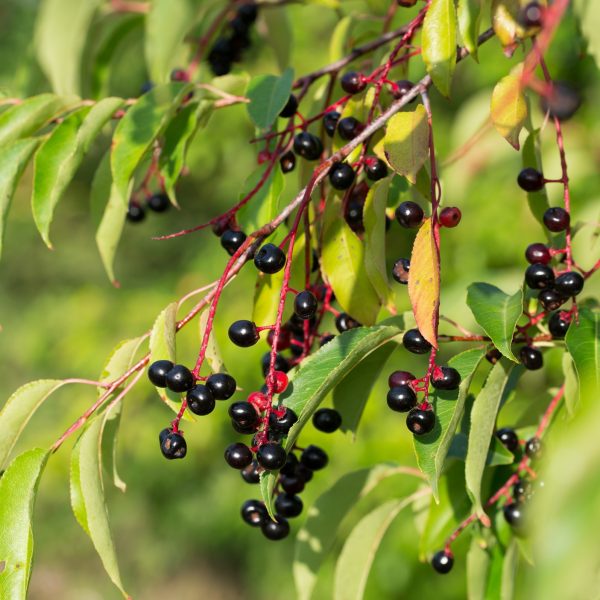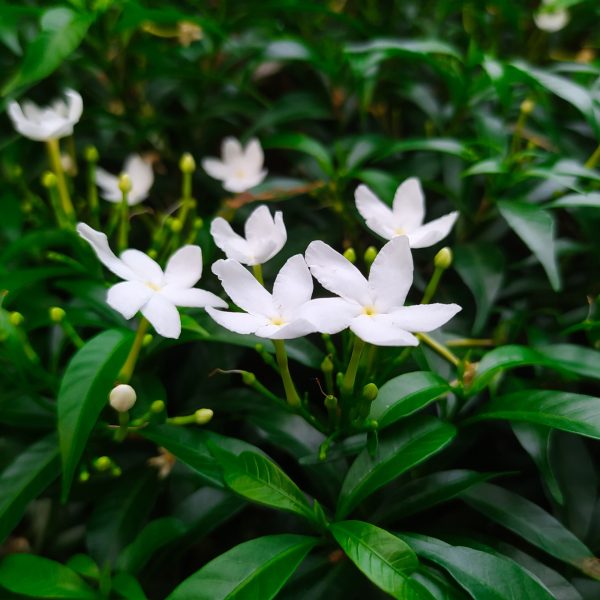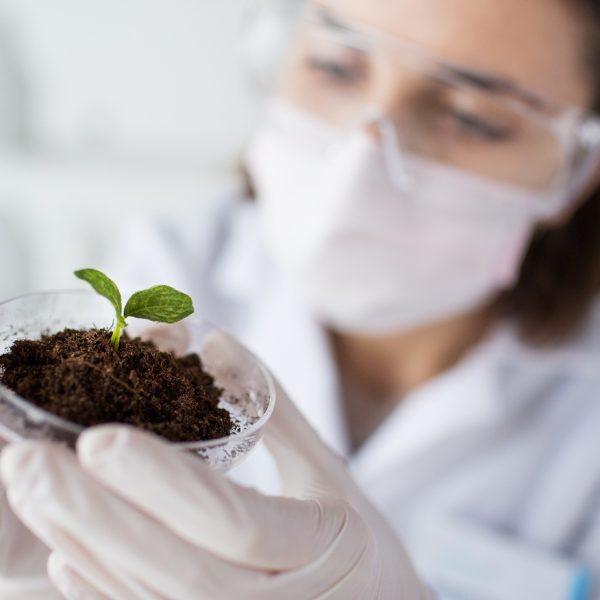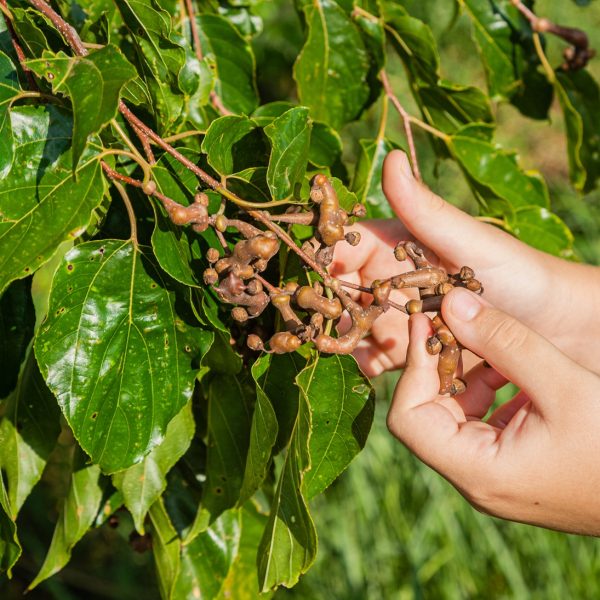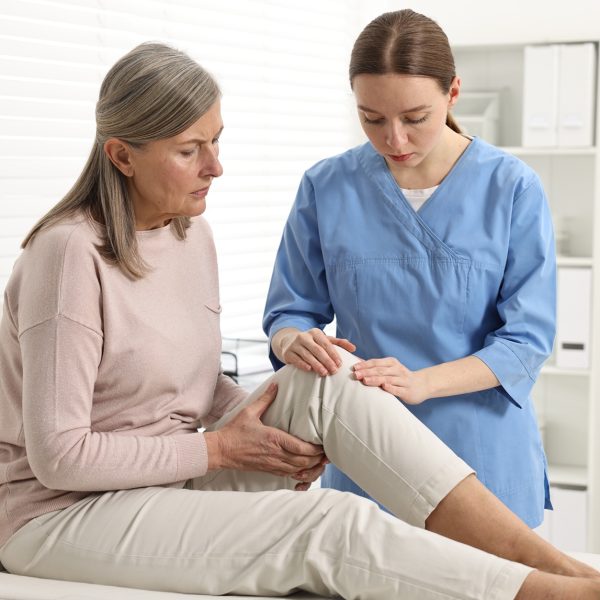-
How does it feel?
An infusion of the dried leaf or bark smells bitter, acrid, slightly sweet, and has some citrusy high notes. The sour and bitter smells indicate the antioxidant and astringent action of the condensed and hydrolysable tannins. There is a slightly clinical, sterile smell, reminiscent of disinfectant which is mildly ammonia-like, giving a clue to the antimicrobial properties.
The deep orange, brown or red colour indicates the antioxidant action of the pro-anthocyanins. A film develops on the tea, which sticks to the cup as it cools, due to the high tannin content.
The primary taste and sensation is astringent, leaving a dry and tacky coating in the mouth. This is due to the presence of a range of tannins, which astringe the membranes of the mouth and throat. There is a slightly sharp and sour taste initially, due to the anti-inflammatory and antioxidant flavonoids (1). The combination of the sour flavour and the astringent sensation of the tannins in the mouth is quite intense, and you might find you have had enough after just a few sips.
-
What can I use it for?

Witch hazel flowering (Hamamelis virginiana) Witch hazel is most commonly used externally for the astringent and anti-inflammatory properties, which are due to the high concentration of tannins.
Externally, it can be used on bruises, swellings, varicose veins, cuts, grazes, insect bites, stings and to stop bleeding (2). Witch hazel is particularly useful and efficacious in the treatment of haemorrhoids, where it can be used as a wash, compress, added to an ointment, or used as an ingredient in suppositories (3,4). The tannins will stop bleeding, speed healing, reduce inflammation and swelling, reduce pain and create a protective barrier to prevent infection (2).
It is commercially available as distilled witch hazel, which is a steam distillation with a small amount of alcohol (~15%) to act as a preservative (5). The distilled preparations have a low tannin content, and a water infusion or tincture will be more efficacious where the astringent action of the tannin content is required (5,6).
Witch hazel can be used as a gargle for sore throats, a mouthwash for bleeding gums, or added to a neti-pot/ sinus flush for inflamed nasal membranes or a streaming nose (3,4,7).
Witch hazel can be taken internally as a tea or tincture for the astringent effects (3,8). This can aid with internal wound healing of stomach ulcers or a damaged intestinal lining (3). In the intestines, witch hazel will reduce inflammation and tighten the gut lining, reducing excessive mucus secretion and improving symptoms of diarrhoea (3). Caution is warranted in cases where the intestines are very sore and inflamed, as the tannins can cause further irritation (8).
-
Into the heart of witch hazel
Witch hazel is cooling, drying and constricting (7,9,10). It is suited to a tissue state which is relaxed, flaccid, has lost tone or has become prolapsed (9). The loss of tone means fluids can run freely from the tissue or membrane, resulting in a loss of fluid via excess mucus, bleeding or diarrhoea (9). The tannins present in witch hazel directly tighten the surfaces it comes into contact with, toning these relaxed tissues (11). The inability to hold fluids or other substances leads to a loss of nutrients as well as function (1). The drying and constricting energetics of witch hazel are indicated when there is a loss of fluids through the channels of elimination in the body, such as the skin, lungs, colon and via menses (9). Witch hazel is very drying, so not suited to individuals with a dry constitution, and may cause irritation in such individuals (9).
Used as a flower essence, it is for people who put themselves under pressure to live up to the expectations of others (2).
-
Traditional uses

Witch hazel tree (Hamamelis virginiana) Native Americans used it as a snuff for nosebleeds and mixed it with flaxseeds to make poultices for painful swellings and tumours (4,12). A tea extract was made by boiling and steeping the twigs and leaves to be used for burns, boils and wounds of every description (13). In the 1840s the first witch hazel distillate was prepared by Theron T. Pond, an “Indian Medicine Man”, and the extract was first produced commercially in 1848 (13).
Witch hazel appeared in the Kings America Dispensary in 1898 as a tonic astringent with a pronounced sedative action (14). A decoction of the bark was considered very useful in haemoptysis (coughing up blood), hematemesis (vomiting blood) and other haemorrhages, as well as in diarrhoea, dysentery, and excessive mucous discharges (14). It was employed primarily as a tonic for the venous structures, for varicose veins, phlebitis, haemorrhoids, haemorrhages, and other conditions of venous engorgement due to vascular relaxation (14). Witch hazel was also a valuable remedy for chronic uterine congestion, an enlarged or prolapsed cervix, and leucorrhoea (vaginal discharge) (14).
In menorrhagia, uterine haemorrhage after abortion or following delivery at full term, Felter considered there was no remedy that exerted such beneficial effects as witch-hazel. The dose was half-teaspoonful mixed with water and repeated every few minutes while the flow lasted, and afterward every few hours to prevent a return of the haemorrhage (14). Witch hazel was also a popular external remedy for sprains, contusions, wounds, swellings, burns, scalds, cuts, and skin inflammations (14).
In the early twentieth century, Grieve states that a tea of the leaf or bark should be consumed freely to remedy bleeding of the stomach and bowels (12). An injection of the tea into the anus was reported as “excellent for inwardly bleeding piles, the relief being marvellous and the cure speedy” (12). Similarly, an ointment made from one part fluid extract and nine parts ointment was recommended for local application or added to suppositories (12). Grieve suggested that a lint bandage soaked in witch hazel and applied to a burst varicose vein would instantly stop the bleeding and could prove life-saving (12).
-
Traditional actions
Herbal actions describe therapeutic changes that occur in the body in response to taking a herb. These actions are used to express how a herb physiologically influences cells, tissues, organs or systems. Clinical observations are traditionally what have defined these actions: an increase in urine output, diuretic; improved wound healing, vulnerary; or a reduction in fever, antipyretic. These descriptors too have become a means to group herbs by their effects on the body — herbs with a nervine action have become the nervines, herbs with a bitter action are the bitters. Recognising herbs as members of these groups provides a preliminary familiarity with their mechanisms from which to then develop an understanding of their affinities and nuance and discern their clinical significance.
-
Traditional energetic actions
Herbal energetics are the descriptions Herbalists have given to plants, mushrooms, lichens, foods, and some minerals based on the direct experience of how they taste, feel, and work in the body. All traditional health systems use these principles to explain how the environment we live in and absorb, impacts our health. Find out more about traditional energetic actions in our article “An introduction to herbal energetics“.
-
What practitioners say

Witch hazel twig (Hamamelis virginiana) Skin
Witch hazel is most commonly used as an external application for inflamed skin conditions. The bark and leaves can be used to make a decoction to use as a wash or compress. A cream or ointment can be made from a decoction, tincture or distilled water.
The high tannin content suits witch hazel to skin conditions that require drying, toning, or tightening. The tannins precipitate proteins in skin cells and mucous membranes to tighten the surfaces, and heal wounds (7,11). This astringent and styptic action of the tannins will stop bleeding, speed healing, reduce inflammation and swelling, lessen pain, and provide a protective coat on wounds and cuts to prevent infection (4). Witch hazel can also be applied to grazes, boils, bedsores, scalds, burns, insect bites and stings (4).
It can be applied to skin which is fragile with a tendency to bleed, particularly after steroid therapy (4). It is healing for bruises, phlebitis (inflammation of the vein, commonly leg), capillary fragility, and chilblains (8). The procyanidins in witch hazel bark reduce skin irritation, and erythema (skin redness and inflammation) and increase the proliferation of human keratinocytes (skin cells) to aid skin regeneration (15). Research has demonstrated the application of witch hazel ointments to minor skin damage can decrease inflammation and erythema (16,17,18,19), more effectively than an antihistamine cream (18), but is not as effective as hydrocortisone cream (17,18).
For wet and weepy eczema, a wash containing witch hazel can dry up the extrusion and reduce the inflammation (5). Research has shown that a cream containing witch hazel extract is effective for treating atopic dermatitis (20,21), nappy dermatitis (19), but not contact dermatitis (20).
It has been used as an ingredient in after-sun lotion, and used to treat sunburn (22). Several clinical trials have demonstrated the efficacy of witch hazel at reducing skin inflammation and erythema as a result of UV damage (16,17,18).
Along with the effect of the tannins in healing tissues to prevent infection, witch hazel has additional antiviral and antibacterial actions (5). The tannins in the bark have antiviral effects against influenza A virus, human papillomavirus (HPV) (23), and Herpes simplex virus type 1 (HSV-1) (24). The distillate is antibacterial against Staphylococcus aureus, Escherichia coli, Bacillus subtilis, Enterococcus faecalis and Candida albicans (5).
In addition to the astringent effect of the tannins in healing skin cells, gallotannins, proanthocyanidins and gallates are highly active free radical scavengers, accounting for the antioxidant action which protects the skin from free radical induced damage (25). Witch hazel water can be spritzed on the skin as skin toner and anti-wrinkle agent, as well as being refreshing for tired skin (8,26).
The astringent action is effective at quelling a nosebleed, by applying a plug of a saturated cotton swab (26).
Eyes
A saturated swab of witch hazel extract placed over eyes is effective to refresh sore or tired eyes (26). To treat conjunctivitis, 10 drops of distilled extract can be added to an eye-bath (26).

Witch hazel branch (Hamamelis virginiana) Cardiovascular
When applied to the skin, the tannins in witch hazel tighten up skin cell layers and the superficial vascular structures (27). This improves the vascular tone and decreases vascular permeability, improving local inflammation and oedema (8). This effect is specific to veins, tightening the walls of the vessels, relieving the swelling and pain of varicose veins, healing varicose ulcers and indicating witch hazel application for diseases of venous dilation (4,9).
Topically applying witch hazel water, ointment or suppositories can offer relief from the itching, discomfort, irritation, and burning associated with anorectal disorders including haemorrhoids and anal fissure (8,10). Since the tannins are largely removed by the distillation process, the astringent properties of witch hazel water are mainly a result of the alcohol content (27). Calendula and rose petals combine well with witch hazel leaves and bark to make a strong decoction which can be used as a wash or soak. The decoction is poured into a bowl which can be sat into several times per day. A decoction or other fluid preparation can be used to soak a cotton pad or linen and used as a compress applied directly to the inflamed tissues (29).
Musculo-skeletal
Ointment, compress or bath soak is relieving for bruises, strains, sprains, swellings and aching muscles (4).
Respiratory
When taken internally the tannins have a drying effect on the mucous membranes of the nasal passages and lungs, which is useful when there is excess nasal mucus discharge or chronic bronchitis (9).
A nasal douche can help with chronic catarrh, hayfever, common cold and other allergies (9,12)
Witch hazel is a useful addition to a gargle for chronic pharyngitis, tonsillitis, swollen tonsils, sore throat, or laryngitis (4,9).
Digestive
Witch hazel can be used in a mouthwash to treat bleeding or infected gums and mouth ulcers, and as a gargle for a sore throat (4,5). The antibacterial activity is effective against periodontal infective pathogens (5).
Astringent properties make it as useful as an internal treatment for several symptoms in the gastrointestinal tract. It acts as a haemostatic to reduce internal bleeding which can occur with ulcers in stomach and intestine (9). The tannins are anti-inflammatory for the gastrointestinal mucosa and will reduce mucus discharges throughout the intestines (9). Witch hazel can be used as a treatment when there is persistent vomiting, haematemesis (vomiting blood) or vomiting with mucus (5,9). The tannins have a drying and binding effect in the gut and will relieve diarrhoea and dysentery (4). These combined actions make witch hazel effective when there are inflamed mucosa in mucus colitis, enteritis, and gastritis (5,8,9). However, caution is required with highly inflamed intestinal membranes and the tannins may cause irritation (8).
Reproductive
Witch hazel can be taken internally for menorrhagia (excessive bleeding during menstruation), uterine blood stagnation, heaviness and discomfort around menstruation, and dysmenorrhoea (4,8). It can also be added to a treatment for uterine prolapse, and tone the uterine muscles after miscarriage and childbirth (4).
Applied topically as a wash, douche, or pessary the astringent effect on the mucous membranes will reduce excess excretions and dry up mucus discharges (4,7). Witch hazel can be used for vaginal discharge, irritation, leucorrhoea and thrush (4,5,7).
Witch hazel can be used as a wash or added to an ointment for use after an episiotomy (5). The pain-relieving benefit is comparable to either an ice pack or a hydrocortisone cream containing a local analgesic (5).
-
Research

Witch hazel flowers (Hamamelis virginiana) Haemorrhoids
Moosmann carried out a double-blind clinical study comparing witch hazel ointment to a corticosteroid for the treatment of haemorrhoids in 90 patients. The preparations had similar efficacy but the witch hazel was more effective at relieving the symptoms of itching, soreness, and bleeding (8).
Skin inflammation
Minor skin irritation and erythema was induced by UV-B irradiation in 24 healthy subjects to assess the anti-inflammatory effects of a witch hazel cream (17). A hydrocortisone cream (1%), and a chamomile cream were compared to the witch hazel cream (2.56 mg/100 g) at four, eight and 24 hours after the skin damage. The witch hazel cream relieved the erythema to a greater extent than the chamomile, although it was not as effective as the hydrocortisone, which was the only cream to demonstrate a significant improvement (17).
Hughes-Formella et al. also used a UV-B irradiation model to compare a propriety sun lotion to a sun lotion containing 10% witch hazel distillate (16). After the irradiation, one of the two test lotions were applied to 30 healthy volunteers, and skin erythema was measured at seven and 48 hours. In the witch hazel group, the erythema suppression was 20% at 7 hours and 27% at 48 hours, compared to only 11–15% for the lotion without the witch hazel extract (16).
In a follow-up study in 2002, Hughes-Formella et al. recruited 40 volunteers to compare the efficacy of a witch hazel lotion to an antihistamine lotion (0.1% dimethindene malate), a hydrocortisone cream (1%) and a hydrocortisone lotion (0.24%) (18). Following UV skin irradiation the test lotions were applied regularly over a 48 hour period, and inflammation and erythema assessed at 24, 48 and 72 hours. The hydrocortisone lotions were the most effective at suppressing erythema, and the witch hazel was more effective than the antihistamine lotion. Although the effect was no greater than the hydrocortisone, there was a significant anti-inflammatory action and suppression of erythema (skin redness) from an after-sun lotion containing 10% distilled witch hazel (18).
Wolff and Kieser compared a witch hazel distillate ointment to dexpanthenol ointment in children aged from 27 days to 11 years old, with minor skin injuries, diaper dermatitis, or localised inflammation of skin. The efficacy of both ointments was statistically significant and clinically relevant, with the witch hazel being as effective as a dexpanthenol ointment. It was concluded that witch hazel ointment is an effective and safe treatment for certain skin disorders in children (19).
Eczema
Pfister et al. carried out a double-blind, placebo-controlled trial of witch hazel salve (25% distillate) involving 80 patients with primary irritant contact dermatitis and 31 patients with atopic eczema. It was demonstrated that atopic eczema responded to the treatment to a greater extent than to placebo, but that there was no significant effect on contact dermatitis (20).
In a 14-day, randomised, double-blind trial, 72 patients with moderately severe atopic eczema were treated with either a witch hazel distillate cream (5.35% distillate), hydrocortisone cream 0.5%, or placebo cream (21). In all three groups there was a significant reduction in itching, erythema and scaling. Although the witch hazel was less effective than the hydrocortisone cream, it was more effective than the placebo cream.
-
Did you know?
The Latin name Hamamelis comes from the Greek, to indicate its resemblance to an apple tree (12). However, the name “witch” hazel comes from its use as a divining rod for water and metal, which was known in ancient Britain as “witching” (2,7).
Additional information
-
Botanical description
Witch hazel is a medium sized deciduous shrub, or small tree, which grows in a temperate biome (29,32). It grows up to five metres tall, three metres wide, is multi-trunked with arched branches and alternate, hazel-like toothed leaves (22). Leaves are broadly oval, up to 15 cm long, 7 cm broad, with dentate or crenate margins (25). The leaves drop in autumn and then it develops bright, spidery, yellow flowers in November (4,9,12). Flowers are hermaphrodite with both male and female organs (22). Flowers consist of yellow stringy petals with a burgundy centre, grouped in bunches of 2–3 along the branches (8,29).
-
Common names
- Winterbloom
- Spotted or striped alder
- Virginian witch hazel
- Snapping hazelnut
- American witch hazel
- Common witch hazel
-
Safety
Witch hazel is safe to consume, but is more typically used externally, and should only be taken internally for short periods of time (4). The high tannin content can cause irritation to the stomach and inhibit the absorption of minerals and B vitamins (8,22). Witch hazel is approved by the German Commission E and the American Botanical Council for use for minor skin injuries, local inflammation of skin and mucous membranes, haemorrhoids and varicose veins (11,29). There are a small number of reported cases of redness, burning and contact dermatitis from topical applications (8,19).
-
Interactions
Witch hazel impairs absorption of ephedrine, pseudoephedrine, codeine, theophylline and atropine when taken internally (4). Medicines containing these constituents, as well as supplements containing B vitamins, iron and other minerals, should be taken at a separate time of the day to witch hazel (30).
-
Contraindications
Prolonged internal use should be avoided due to the high tannin content inhibiting nutrient absorption, and internal use is not recommended in cases of malnutrition or anaemia (8,30). Caution is warranted in individuals prone to constipation due to the drying effect in the mucous membranes of the intestines (8).
Witch hazel is considered safe to use during pregnancy, but not recommended during breastfeeding (8). There are no known problems associated with topical use of witch hazel during pregnancy and lactation (11).
You can find qualified medical herbal professionals on our page Where to find a herbalist.
-
Dosage
- Infusion: 1–4 g dried leaf or bark, three times per day (3,5,8)
- Decoction: 5–10 g in 250 ml water for use as wash, irrigation or compress (11,29)
- Tincture: 1–4 ml, 1:5, 40%, three times per day (3,5,8). 20–40 ml per week (6)
- FE (1:1 extract): 45%, 2–4 ml, three times per day (5)
- Distilled extract: preserved with 15% alcohol (22). Use 5 ml bark tincture in 50 ml water as an alternative to distillate (22).
Topical preparations:
- Ointment or lotion (10%): Haemorrhoids, varicose veins, insect bites (3,4,27)
- Poultice: 5–10 g dried leaf or bark decocted in 250 ml water (22)
- Compress: 25 g/1 oz leaves in 500 ml/1 pint boiling water, soak pad and apply (26)
- Bath/soak: For swellings and inflammation (10)
- Douche for vaginal discharge and irritation (4,5)
- Gargle for sore throat, tonsillitis, laryngitis (4)
- Mouthwash for bleeding gums and mouth ulcers (4,5)
- Eye-bath: Styes, conjunctivitis, tired eyes (3,5)
- Suppository: 0.1–1 g, applied 1–3 times per day (8,29)
-
Plant parts used
- Bark
- Twigs
- Leaves
-
Constituents
- Tannins (3–12%): Hamamelin, hamamelitannin, gallotannins, catechins, proanthocyanins, gallic acid, pentagalloylglucose (5,8,22,23)
- Flavonoids (5%): Phenolic acids, kaempferol, quercetin, astragalin, quercitrin, afzelin and myricitrin (11,22,23)
- Terpenes: Sesquiterpenoids, monoterpenoids (22,31)
- Polysaccharides: Arabans, arabinogalactans (15)
- Volatile oils (0.5%): Eugenol, safrole, carvacol, hexaenol (7,11,22)
- Saponins and resin (3)

-
Habitat
Witch hazel is native to North America, Canada and Mexico, and propagated throughout Europe and the UK (5,32). It tends to grow in dry to moist woods, valleys, often on banks of streams and in the partial shade at the edge of woodlands, on either flat lands or slopes (22,33). The species is shade tolerant, often growing as an understory tree in the wild, preferring part sun and part shade (4,33).
-
Sustainability
 Witch hazel is reported as ‘secure’ by Nature Serve since it is widespread and abundantly distributed across North America (34). It is not protected under the U.S. Endangered Species Act (Nature serve), nor does it appear on the United Plant Savers ‘to watch’ list (35). It does not appear on CITES either (36).
Witch hazel is reported as ‘secure’ by Nature Serve since it is widespread and abundantly distributed across North America (34). It is not protected under the U.S. Endangered Species Act (Nature serve), nor does it appear on the United Plant Savers ‘to watch’ list (35). It does not appear on CITES either (36).The International Union for Conservation of Nature (33) have global assessed Hamamelis virginiana and list it as ‘east concern’. They state that the population is stable and the species is widely distributed across USA and Canada, and there are currently no major threats reported (33). According to Angiosperm Extinction-Risk Predictions, Hamamelis virginiana is currently not at threat (32).
The collecting of branches, bark, and foliage for medicinal uses, particularly in North America, appears to be having minimal impact on such an abundant plant (34). “This is apparently having no reported long-term effects on its abundance and genetic diversity, particularly since most collecting is by repeated harvest of new growth from the same rootstocks” (34).
Habitat loss and over-harvesting from the wild are two of the biggest threats faced by medicinal plant species. There are an increasing number of well-known herbal medicines at risk of extinction. We must, therefore, ensure that we source our medicines with sustainability in mind.
The herb supplement industry is growing at a rapid rate and until recent years a vast majority of medicinal plant produce in global trade was of unknown origin. There are some very real and urgent issues surrounding sustainability in the herb industry. These include environmental factors that affect the medicinal viability of herbs, the safety of the habitats that they are taken from, as well as the welfare of workers in the trade.
The botanical supply chain efforts for improved visibility (transparency and traceability) into verifiably sustainable production sites around the world is now certificated through the emergence of credible international voluntary sustainability standards (VSS).
Read our article on Herbal quality and safety: What to know before you buy and Sustainable sourcing of herbs to learn more about what to look for and questions to ask suppliers about sustainability.
-
Quality control
Herbal medicines are often very safe to take, however, it is important to buy herbal medicines from a reputed supplier. Sometimes herbs bought from disreputable sources are contaminated, adulterated or substituted with incorrect plant matter.
Some important markers for quality to look for would be to look for certified organic labelling, ensuring that the correct scientific/botanical name is used and that suppliers can provide information about the source of ingredients used in the product.
A supplier should be able to tell you where the herbs have come from. There is more space for contamination and adulteration when the supply chain is unknown.
-
How to grow
The woody seed capsules form after the flowers and stay on the branch to mature until the following year when they burst open, sending out the small black seeds (22). Witch hazel grows slowly, and after reaching a height of about three metres (10 feet), it sends all new growth in a lateral direction (34). It can be grown from the seed dispersal, but often spreads by roots that grow new aerial stems (34). It does not need frost protection and is very hardy, tolerating temperatures as low as minus 35°C (37). It is best to be thinned or pruned in January/February when the plant is dormant (22). The leaves are gathered throughout the summer, but the bark is gathered in spring after it has sprouted (3).
-
Recipe
Vein soothing lotion*
Ingredients
- 250 g aloe vera gel or plain base cream
- 10 ml horse chestnut leaf infused oil
- 10 ml calendula oil
- 10 ml horse chestnut seed tincture
- 10 ml yarrow tincture
- 10 ml witch hazel tincture
- 10 ml witch hazel distilled water
- 20 ml peppermint or rosemary essential oil
Method
- Place the aloe vera or base cream in a bowl and gradually whisk in the oils, one teaspoon at a time. Use the same method to gradually add the tincture, whisking thoroughly, before adding the essential oil and then witch hazel water.
- Apply twice per day to varicose veins, thread veins or haemorrhoids.
* Adapted from Chown and Walker (29)
-
References
- Maier K. Energetic Herbalism: A Guide to Sacred Plant Traditions Integrating Elements of Vitalism, Ayurveda, and Chinese Medicine. Chelsea Green Publishing; 2021.
- McIntyre A. Flower Power: flower remedies for healing body and soul through herbalism, homoeopathy, aromatherapy, and flower essences. Henry Holt; 1996.
- Hoffmann D. Medicinal Herbalism, The Science and Practice of Herbal Medicine. Healing Arts Press; 2003.
- McIntyre, A. The Complete Herbal Tutor: The Definitive Guide to the Principles and Practices of Herbal Medicine. Aeon Books, 2019.
- Fisher C. Materia Medica of Western Herbs. Aeon Books; 2018.
- Thomsen M. The Phytotherapy Desk Reference: 6th Edition. 6th ed. Aeon Books; 2022.
- Mars, B. The Desktop Guide to Herbal Medicine. Basic Health Publications Inc; 2007.
- Bone K and Mills S. Principles and Practice of Phytotherapy: Modern Herbal Medicine. Elsevier Health Sciences; 2013.
- Wood M. The Earthwise Herbal Volume 2: A Complete Guide to New World Medicinal Plants. North Atlantic Books; 2008.
- Easley T, Horne S. The Modern Herbal Dispensatory: A Medicine-Making Guide. North Atlantic Books; 2016.
- Barnes, J., Anderson, L.A. and Phillipson, J.D. Herbal medicines: a guide for healthcare professionals: Third Edition. Pharmaceutical press; 2007.
- Grieve M, Leyel CF, Marshall M. A Modern Herbal. the Medicinal, Culinary, Cosmetic and Economic Properties, Cultivation and Folk-Lore of Herbs, Grasses, Fungi, Shrubs & Trees with All Their Modern Scientific Uses. Dover Publications; 1982.
- Lloyd JU and Lloyd JT. History of Hamamelis (witch hazel) extract and distillate. Journal of the American Pharmaceutical Association. 1935;24(6). Accessed July 21, 2024. https://swsbm.henriettesherbal.com/ManualsOther/Hamamelis.pdf
- Felter H. W, Lloyd J. U (1898) Kings American Dispensary 18th Edit. Reprinted on Henritttas Herbpages. Accessed July 20, 2024. https://www.henriettes-herb.com/eclectic/kings/hamamelis.html
- Deters, A., Dauer, A., Schnetz, E., Fartasch, M. and Hensel, A. High molecular compounds (polysaccharides and proanthocyanidins) from Hamamelis virginiana bark: influence on human skin keratinocyte proliferation and differentiation and influence on irritated skin. Phytochemistry. 2001; 58(6);949-958. https://doi.org/10.1016/S0031-9422(01)00361-2
- Hughes-Formella, B.J., Bohnsack, K., Rippke, F., Benner, G., Rudolph, M., Tausch, I. and Gassmueller, J. Anti-inflammatory effect of hamamelis lotion in a UVB erythema test. Dermatology. 1998;196(3);316-322. https://doi.org/10.1159/000017904
- Korting HC, Schäfer-Korting M, Hart H, Laux P, Schmid M. Anti-inflammatory activity of hamamelis distillate applied topically to the skin: influence of vehicle and dose. European journal of clinical pharmacology. 1993;44:315-8. https://doi.org/10.1007/BF00316465
- Hughes-Formella, B.J., Filbry, A., Gassmueller, J. and Rippke, F. Anti-inflammatory efficacy of topical preparations with 10% hamamelis distillate in a UV erythema test. Skin Pharmacology and Physiology. 2002; 15(2);125-132. https://doi.org/10.1159/000049400
- Wolff, H.H. and Kieser, M. Hamamelis in children with skin disorders and skin injuries: results of an observational study. European Journal of Pediatrics. 2007;166(9);943-948. https://doi.org/10.1007/s00431-006-0363-1
- Pfister et al (1981). Cited by Bone K and Mills S. Principles and Practice of Phytotherapy: Modern Herbal Medicine. Elsevier Health Sciences; 2013.
- Korting HC, Schäfer-Korting M, Klövekon W, Klövekorn G, Martin C, Laux P. Comparative efficacy of hamamelis distillate and hydrocortisone cream in atopic eczema. European journal of clinical pharmacology. 1995;48:461-5. https://doi.org/10.1007/BF00194335
- Stobart, A. The Medicinal Forest Garden Handbook: growing, harvesting and using healing trees and shrubs in a temperate climate. Permanent Publishers; 2020.
- Theisen, L.L., Erdelmeier, C.A., Spoden, G.A., Boukhallouk, F., Sausy, A., Florin, L. and Muller, C.P. Tannins from Hamamelis virginiana bark extract: characterization and improvement of the antiviral efficacy against influenza A virus and human papillomavirus. PloS one. 2014;9(1):88062. https://doi.org/10.1371/journal.pone.0088062
- Erdelmeier, C.A.J., Cinatl, J., Rabenau, H., Doerr, H.W., Biber, A. and Koch, E. Antiviral and antiphlogistic activities of Hamamelis virginiana bark. Planta medica. 1996; 62(03);241-245. DOI: 10.1055/s-2006-957868.
- Heinrich, M., Barnes, J., Prieto-Garcia, J., Gibbons, S. and Williamson, E.M. Fundamentals of Pharmacognosy and Phytotherapy. Third Edition. Elsevier Health Sciences; 2018.
- Bartram, T. Bartram’s Encyclopaedia of Herbal Medicine. Robinson; 2015.
- Natural Medicines Professional Database. Therapeutic Research Centre. Witch Hazel Professional Monograph. Published Nov 16, 2023. Accessed July 21, 2024. https://naturalmedicines.therapeuticresearch.com/
- Blumenthal M, Busse WR. Witch Hazel leaf and bark. In: The Complete German Commission E Monographs: Therapeutic Guide to Herbal Medicines. American Botanical Council; 1999. Accessed July 21, 2024. https://www.herbalgram.org/resources/commission-e-monographs/monograph-approved-herbs/witch-hazel-leaf-and-bark/
- Chown V and Walker K. The Handmade Apothecary: Healing Herbal Remedies. Kyle Books; 2017.
- Brinker, FJ. Herbal Contraindications & Drug Interactions: Plus Herbal Adjuncts with Medicines. Eclectic Medical Publications, 2010.
- Pengelly A. The constituents of medicinal plants: an introduction to the chemistry and therapeutics of herbal medicine. CABI Publishing; 2004.
- Royal Botanical Gardens Kew (RBGK). Hamamelis virginiana L. Plants of the Word Online (POWO). Accessed July 20, 2024. https://powo.science.kew.org/taxon/urn:lsid:ipni.org:names:430697-1
- IUCN red list of threatened species: Hamamelis virginiana. IUCN. February 12, 2018. Accessed July 20, 2024. https://www.iucnredlist.org/species/62018973/62018975
- NatureServe explorer 2.0. Natureserve.org. Accessed July 20, 2024. https://explorer.natureserve.org/Taxon/ELEMENT_GLOBAL.2.128564/Hamamelis_virginiana
- UpS list of herbs & analogs. United Plant Savers. Published May 14, 2021. Accessed July 20, 2024. https://unitedplantsavers.org/ups-list-of-herbs-analogs/
- Convention on International Trade in Endangered Species of Wild Fauna and Flora (CITES). Accessed July 20, 2024. https://checklist.cites.org/#/en
- PFAF (2024). Hamamelis virginiana L., Witch Hazel PFAF Plant Database. Accessed July 20, 2024. https://pfaf.org/user/Plant.aspx?LatinName=Hamamelis+virginiana

